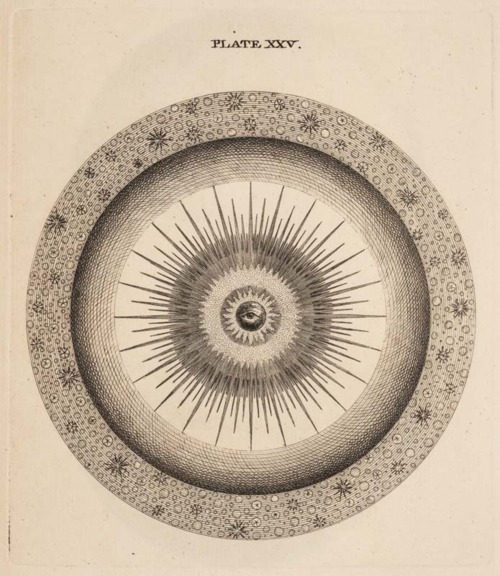
| Readings: |
Cosmological Principle Hubble's law |
Wright's Universe:
Combining astronomical and theological concepts, Thomas Wright (1711-1786) proposed a version of the Universe where the stars are arranged in a spherical shell separated from a supernatural center by a huge gap. The stars are in motion about the center, like planets. And the stars form individual solar systems that make up the Milky Way galaxy.

The center of Wright's Universe is the domain of a divine Presence, who is responsible for all the motion of the stars. Wright's Universe is modified by Immanuel Kant (1724-1804) who saw the stars not as an unordered crowd, but an ordered system lying in a plan moving by motions guided by Newton's laws of motion.

In addition, Kant is the first to proposed that stars group together into ``World Systems". This is the first example of the concept of island universe or galaxies outside the Milky Way. This will later be proven by Hubble, who discovered Cepheid variables in nearby galaxies.
Cosmological Principle:
Observations to date support the idea that the Universe is both isotropic and homogeneous. Both facts are linked to what is called the cosmological principle. The cosmological principle derives from the Copernican Principle but has no foundation in any particular physical model or theory, i.e. it can not be `proved' in a mathematical sense. However, it has been supported by numerous observations of our Universe and has great weight from purely empirical grounds.
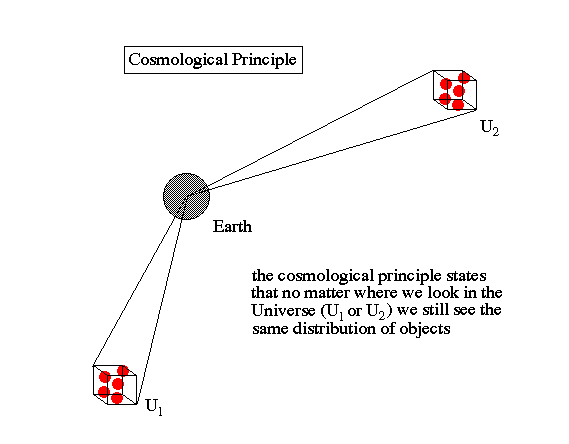
The cosmological principle, basically asks the question of whether the Universe is isotropic and homogeneous. These two terms are not equivalent and have a special meaning to cosmology. Isotropy means there are no special directions to the Universe, homogeneous means there are no special places in the Universe.
Again, while these two definitions appear similar, they describe very different properties to the Universe as a whole. For example, if the Universe is isotropic then this means you will see no difference in the structure of the Universe as you look in different directions. When viewed on the largest scales, the Universe looks the same to all observers and the Universe looks the same in all directions as viewed by a particular observer. Homogeneity, when viewed on the largest scales, means that the average density of matter is about the same in all places in the Universe and the Universe is fairly smooth on large scales.
Notice that this is clearly not true for the Universe on small scales such as the size of the Earth, the size of the Solar System and even the size of the Galaxy. Terms such as look the same and smooth in density are applied only on very large scales. For cosmology, we only consider the isotropy and homogeneity of the Universe on scales of millions of light-years (the distance it takes light to travel in one year, is roughly 1018 cm) in size.
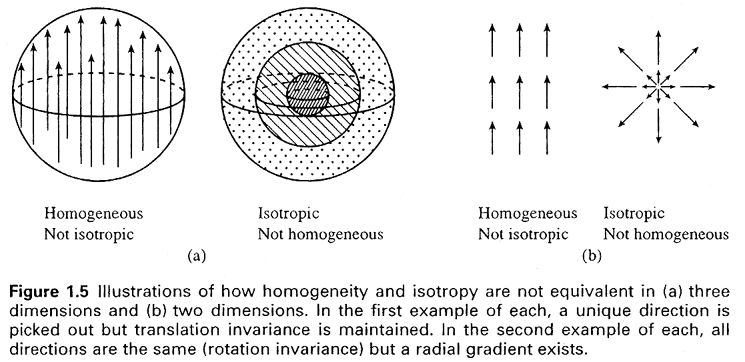
An isotropic Universe also means that there is no `center' to the Universe. The rotation of the Earth produces a unique orientation (i.e. north and south poles), but the Universe appears the same from any position. This is an important point when we consider the origin of the Universe known as the Big Bang. Due to isotropy, there is no `place' where the Big Bang occurred, there is no center point. Empedocles stated it best by saying `God is an infinite sphere whose center is everywhere and circumference nowhere.
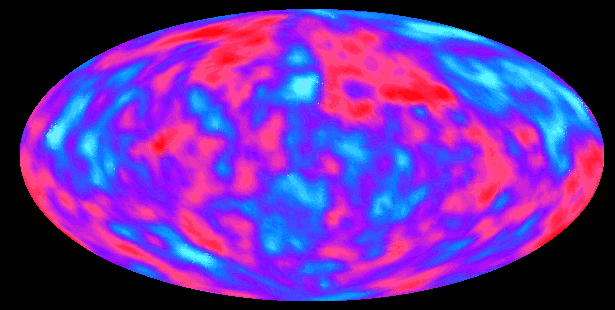
The greatest consequence of the cosmological principle is that it implies that all parts of space are causally connected at some time in the past (although they may no longer be connected today). Thus, a homogeneous Universe leads to the conclusion that the whole Universe appeared at a single moment of time, a Creation.
Lastly, we is we extend the cosmological principle through time we have the `perfect' cosmological principle, that the Universe is isotropic and homogeneous, and has been for all time. This means that the laws of Nature are unchanging and that things we observe from the past can be assumed to operate under that same physics as things today.
Lookback Time:
The large size of the Universe, combined with the finite speed for light, produces the phenomenon known as lookback time. Lookback time means that the farther away an object is from the Earth, the longer it takes for its light to reach us. Thus, we are looking back in time as we look farther away.
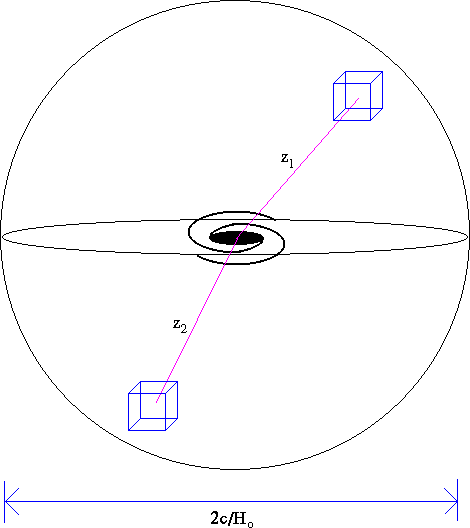
The galaxies we see at large distances are younger than the galaxies we see nearby. This allows us to study galaxies as they evolve. Note that we don't see the individuals evolve, but we can compare spirals nearby with spirals far away to see how the typical spiral has changed with time.
Galaxy Evolution:
The phenomenon of lookback time allows us to actually observe the evolution of galaxies. We are not seeing the same galaxies as today, but it is possible to trace the behavior of galaxies types with distance/time.
It is known that galaxies form from large clouds of gas in the early Universe. The gas collects under self-gravity and, at some point, the gas fragments into star cluster sized elements where star formation begins. Thus, we have the expectation that distant galaxies (i.e. younger galaxies) will be undergoing large amounts of star formation and producing hot stars = blue stars. The study of this phenomenon is called color evolution.
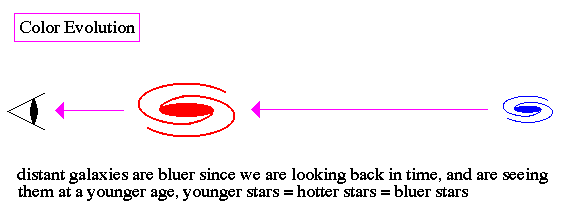
Computer simulations also indicate that the epoch right after galaxy formation is a time filled with many encounters/collisions between young galaxies. Galaxies that pass near each other can be captured in their mutual self-gravity and merge into a new galaxy. Note that this is unlike cars, which after collisions are not new types of cars, because galaxies are composed of many individual stars, not solid pieces of matter. The evolution of galaxies by mergers and collisions is called number evolution.

Thus, our picture of galaxy evolution, incorporating both these principles, looks like the following:
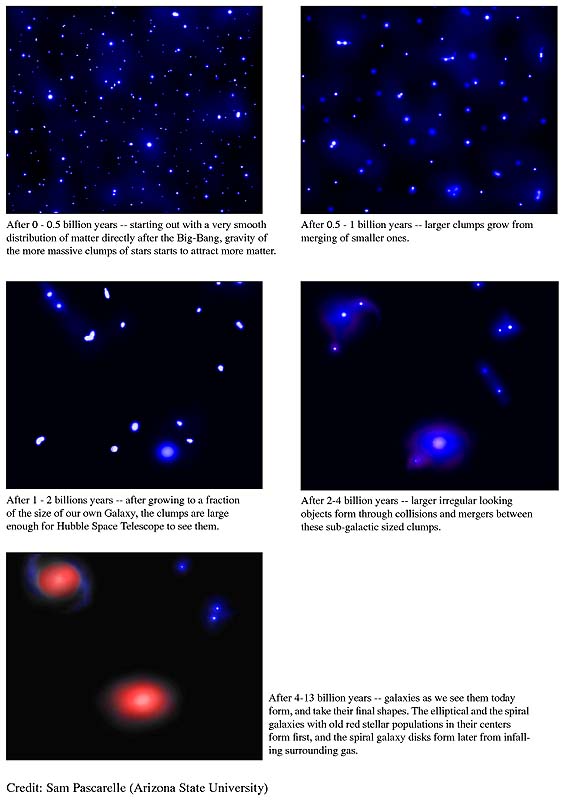
Some types of galaxies are still forming stars at the present epoch (e.g. spiral and irregular galaxies). However, the past was marked by a much higher rate of star formation than the present-day average rate because there was more gas clouds in the past. Galaxies, themselves, were built in the past from high, initial rates of star formation.
The time of quasars is also during the time of first star formation in galaxies, so the two phenomenon are related, the past was a time of rapid change and violent activity in galaxies.
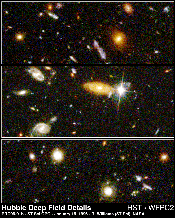
Space observations called the Hubble Deep Field produced images of faint galaxies and distant galaxies at high redshift which confirmed, quantitatively, our estimates of the style and amount of star formation. Nature lends a hand by providing images of distant galaxies by gravitational lensing, as seen in this HST image of CL0024.
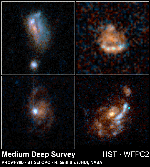
Interestingly enough, it is often easier to simulate the evolution of galaxies in a computer, then use the simulations to solve for various cosmological constants, such as Hubble's constant or the geometry of the Universe. The field of extragalactic studies is just such a process of iteration on the fundamental constants of the Universe and the behavior of galaxies with time (i.e. galaxy evolution).
Static Universe and Hubble's law:
With the discovery that spiral nebula were, in fact, other galaxies external to our own, our concept of a Universe became one of in a Newtonian universe of infinite size and mass, galaxies spread out in infinite space. However, there is a problem with a uniform, static Universe, any density enhancements would become unstable to gravitational collapse. Thus, the whole Universe should have collapsed (or be collapsing) into a giant black hole.
In the 1930's, Edwin Hubble discovered that all galaxies have a positive redshift. In other words, all galaxies were receding from the Milky Way. By the Copernican principle (we are not at a special place in the Universe), we deduce that all galaxies are receding from each other, or we live in a dynamic, expanding Universe. This solves the problem for gravitational collapse, only small regions will collapse to form galaxies. The rest of space keeps expanding.
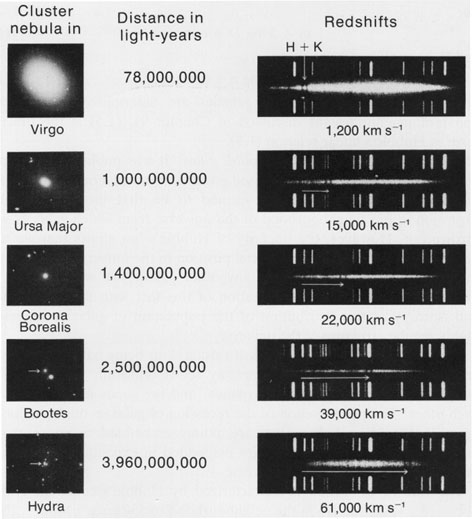
The expansion of the Universe is described by a very simple equation called Hubble's law; the velocity of the recession of a galaxy (determined from its redshift, see below) is equal to a constant times its distance (v=Hd). Where the constant is called Hubble's constant and relates distance to velocity in units of megaparsecs (millions of parsecs).
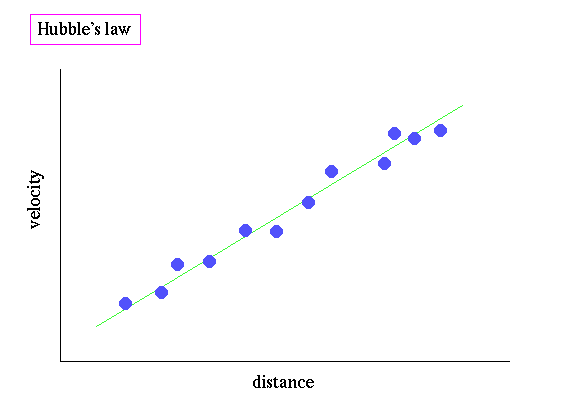
Redshift:
The key observable in extragalactic studies is the redshift of a distant galaxy. All galaxies are made of stars which emit a spectrum of electromagnetic radiation with particular fingerprint-like patterns corresponding to the quantum shells of the various elements in the star's atmospheres. The lines of hydrogen, magnesium and calcium are particularly promenade in galaxies, and can be identified with telescopes using a special instrument called a spectrograph.

A typical galaxy spectrum is shown above where the emission from the galaxy's core (3) is in the center. Also seen in the image are emission lines from the earth's night sky (2), the effects of cosmic rays (5) and a nearby star (6) appear as lines parallel to the core's trace. Dynamics and kinematics of the galaxy are hidden in some wormlike structures (1).
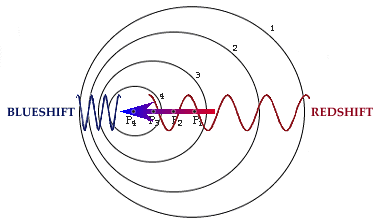
The velocity of a galaxy is measured by the Doppler effect, the fact that light emitted from a source is shifted in wavelength by the motion of the source. The change in wavelength, with respect to the source at rest, is called the redshift (if moving away, blueshift if moving towards the observer) and is denoted by the letter z. Redshift, z, is proportional to the velocity of the galaxy divided by the speed of light. Since all galaxies display a redshift, i.e. moving away from us, this is referred to as recession velocity.
Of course, a key parameter in understanding the distance-redshift relation is the calibration of the whole system. This is know as the problem of the extragalactic distance scale, an ongoing research project for the last 30 years. The primary goal of the distance scale project is to compare the redshift, or recession velocity, of a galaxy with some independent measure of its distance. This is, of course, much more difficult than one would natively think since we can not travel to nearby galaxies, and they are much too far away to observe their motion or parallax.
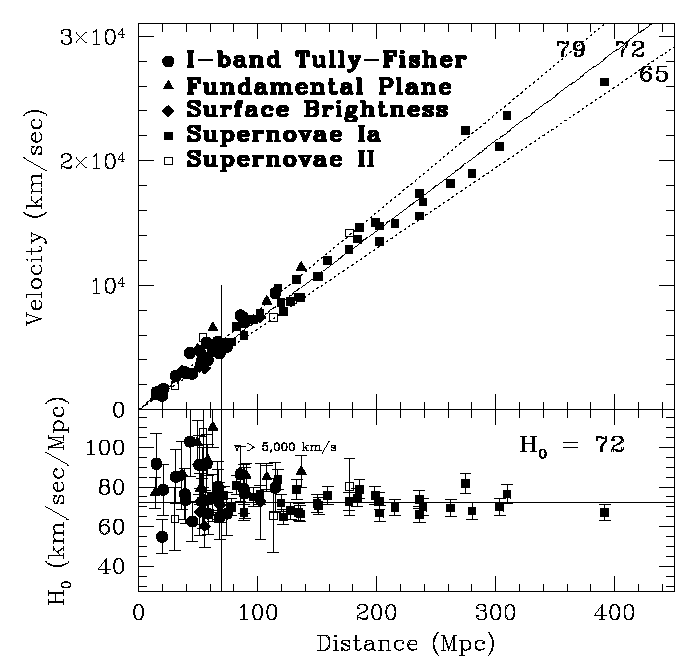
As a result, distance scale work uses a chain of distance indicators working outward from nearby stars to star clusters in our own Galaxy to stars in nearby galaxies. Unusually bright stars, such as variable stars and supernovae, complete the distance ladder out to cosmological distances. The latest results from the Hubble Space Telescope are shown above, a plot of recession velocity with distance (in megaparsecs, millions of light-years). The straight, linear correlation indicates that the Universe is currently expanding at a rate of 72 km per sec for every Mpc. The rate, known as Hubble's constant, may change with time (see next lecture).
Expanding Universe:
A common question in cosmology is "why are all the galaxies receding from each other?" In other words, the cosmological principle requires that we not be at a special place in the Universe. Since all the galaxies are moving away from us, then they must all be moving away from each other. This is explained if the Universe, as a whole, is expanding.
In a real sense, Hubble's law, the recession velocity of galaxies, is an illusion. The galaxies are not moving, the space between them is literally expanded. To see how this produces a Doppler effect, consider a simply Universe that is a circle. To the observers in this type of Universe, they believe they live in a 1D structure. But, in fact, they live in a 2D structure, a circle. The position of the galaxies can be measured by the distance between them (S, see diagram below) or what are called the co-moving coordinates, an angle θ between the galaxies.
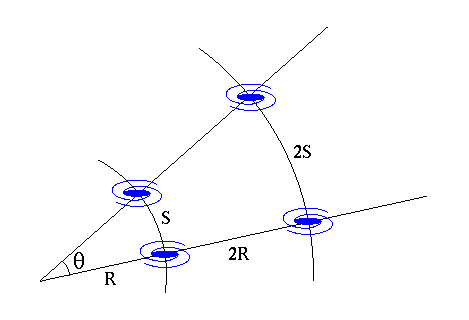
The radius of the Universe is given by R, notice that R is a quantity only seen in 2D space, not measured directly by the inhabitants of the 1D circle unless they measure 2πR by walking around the Universe. Now, we let the Universe expand by a factor of 2, R becomes 2R. The distance between the galaxies becomes 2S, but the co-moving coordinate, angle θ remains unchanged. Since the distance between the galaxies has increased, then the galaxies will appear to have moved apart by S/time of expansion. When, in fact, the galaxies have not moved at all, the space between them has increased.
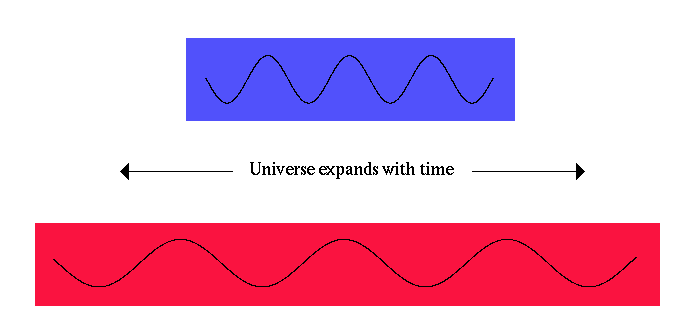
Expanding spacetime also explains the redshift of galaxies, which is interpreted as Doppler motion. Since space expands, any photons traveling through that space (from distant galaxies to us) must also expand, i.e. the photons are `stretched' as they travel across the Universe.
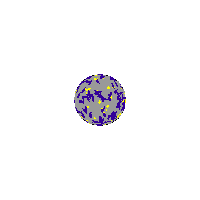
So the redshift we see for distant galaxies is really an effect of spacetime expanding, not real motion. This is good because some of the redshifts for the most distant galaxies have recessional velocities in excess to the speed of light. But this is not a contradiction for special relativity since the space is expanding, not true motion. We will also see that photons created as gamma rays in the early Universe are now redshifted to the microwave region of the spectrum to make up what is called the cosmic microwave background (CMB).
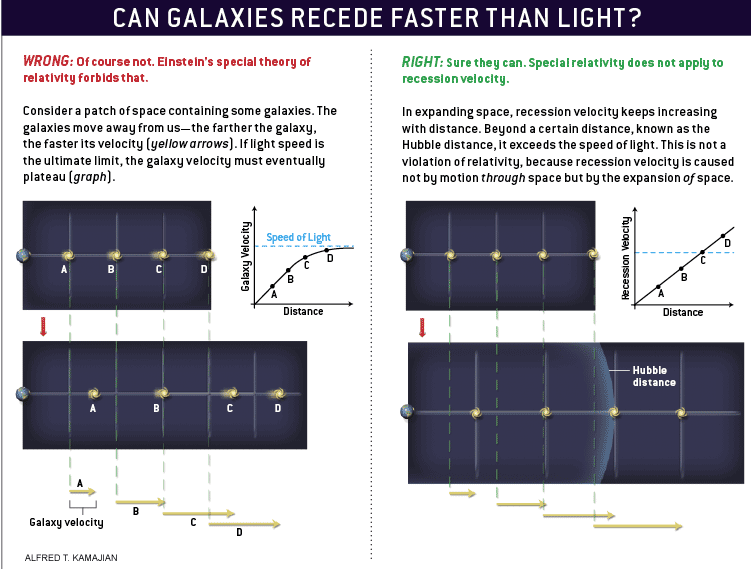
Creation Event:
The debate about the origin of the Universe presupposes that there was an origin. Instead of a beginning, the Universe may be experiencing an endless number of cycles. Ancient Chinese believed that all events formed a periodic pattern driven by two basic forces, Yin and Yang.

Judeo-Christian tradition was unique in its belief that God created the Universe at some specfic moment in the past, and that events form an unfolding unidirectional sequence. Key to this philosophy is that the Creator is entirely separate from and independent of His creation. God brings order to a primordal chaos.
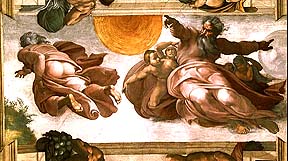
A Creation event implies that everything came from nothing (creation ex nihilo) since if there were something before Creation, than an earlier Creation is needed to explain that something. God existed before Creation, and the definition is not limited to work with pre-existing matter or pre-existing physical laws either. In fact, the most obvious distinction between the Creator and the created Universe is that the Creator is eternal and the created Universe had a beginning.
Hot Big Bang:
The discovery of an expanding Universe implies the obvious, that the Universe must have had an initial starting point, an alpha point or Creation. In other words, there existed a point in the past when the radius of the Universe was zero. Since all the matter in the Universe must have been condensed in a small region, along with all its energy, this moment of Creation is referred to as the Big Bang.
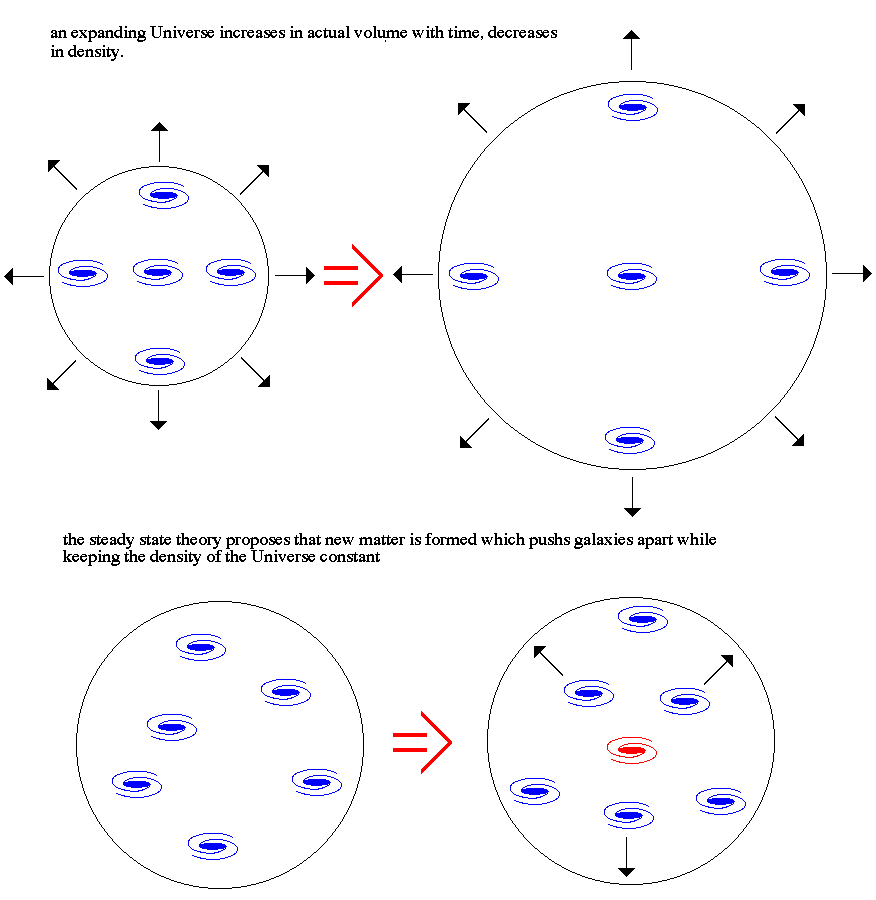
A common question that is asked when considering a Creation point in time is ``What is before the Big Bang?''. This type is question is meaningless or without context since time was created with the Big Bang. It is similar to asking ``What is north of the North Pole?''. The question itself can not be phrased in a meaningful way.
The Big Bang theory has been supported by numerous observations and, regardless of the details in our final theories of the Universe, remains the core element to our understanding of the past. Note that an alpha point automatically implies two things: 1) the Universe has a finite age (about 15 billion years) and 2) the Universe has a finite size (its expanding at a finite speed in a finite time).

|
|

|